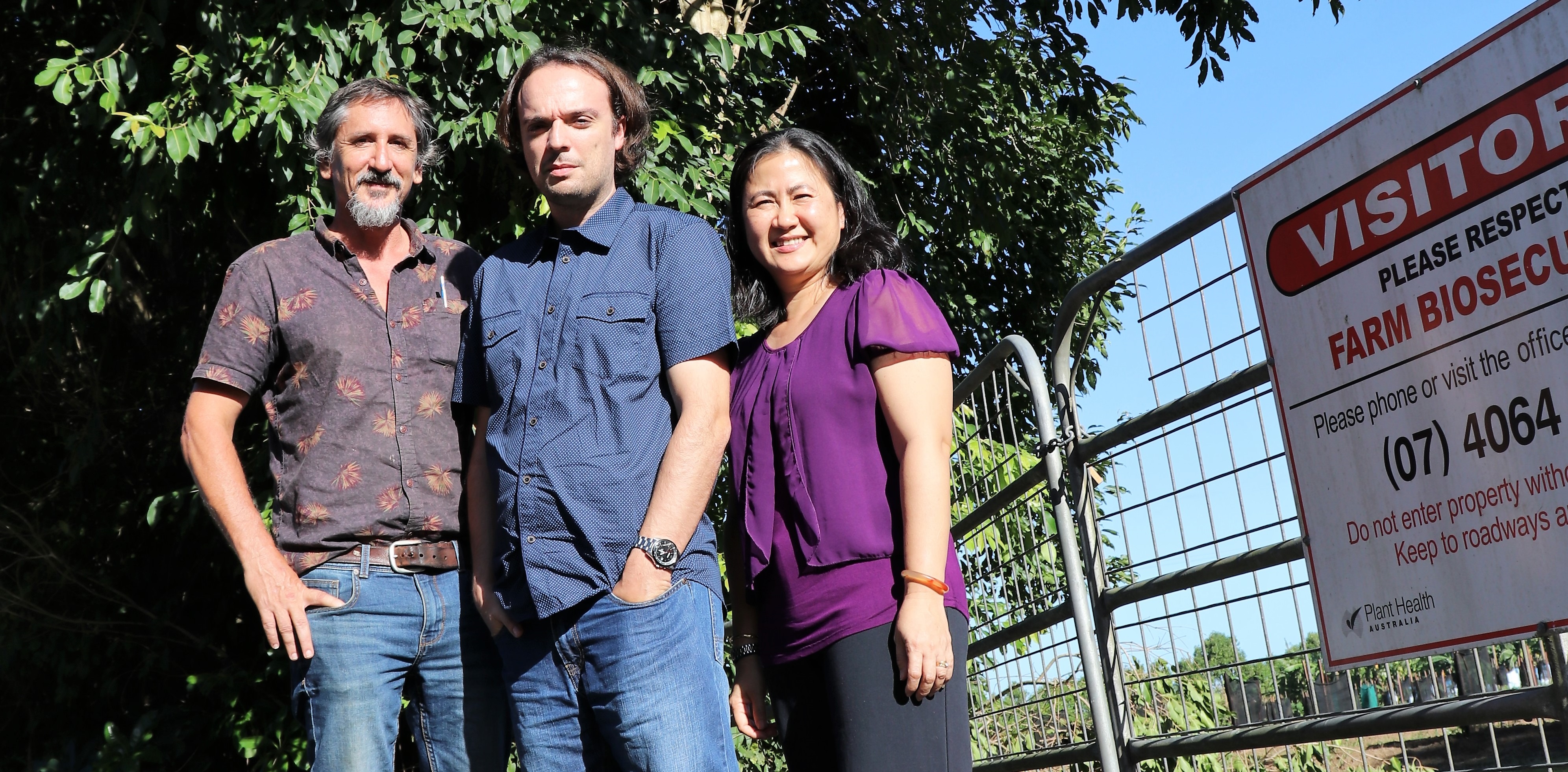In research labs and trial sites around the world, the search for a commercially viable banana variety resistant to Panama TR4 edges closer every day.
As a variety screening trial for TR4 resistance in the Northern Territory draws to a close, the latest results from the program have been promising, including four Cavendish varieties with good resistance to the disease, during the plant crop phase.
By Sharl Mintoff, Vu Tuan Nguyen, Sam Cullen, Chris Kelly and Lucy Tran-Nguyen

A varietal screening trial at Coastal Plains Research Farm in the Northern Territory, originally part of a previous research project, Banana Plant Protection Program (BA10020) is nearing conclusion.
This trial consists of various banana varieties ranging from several Cavendish, FHIA hybrids and parental lines to a wild species native to Australia.
The aim of the trial is to screen and assess these varieties for their resistance to Fusarium wilt Tropical Race 4 (TR4) by assessing the appearance of Fusarium wilt symptoms and survival of the plants.
Typical symptoms of TR4 Fusarium wilt of banana are yellowing of the oldest leaves, followed by the wilting and collapse of these leaves.
In some cases splitting of the outer most leaf sheath can occur at the base of the pseudostem.
Internally, symptoms can be seen as a reddish-brown discolouration of the xylem inside the pseudostem.
Since the last update, the plant crop and most of the first ratoon disease assessment data has been collected with the trial set to end in April this year.
A new varietal screening trial, as part of the new research project Improved Plant Protection for the Banana Industry (BA16001), will commence mid-2018.
This article gives an update on the performance of the plant crop of these varieties and their resistance to TR4.
METHODS
All plants were artificially inoculated with TR4 colonised millet at planting in June 2016 and assessed fortnightly for the appearance of external disease symptoms and internal symptoms at plant death or harvest.
In a previous issue of Australian Bananas, information was presented on the Fusarium Wilt Race 1 variety trial (Issue 51, page 26) where varieties were placed into three categories addressing how susceptible or resistant a particular banana variety was to Race 1, here we use this same system with an additional category.
Resistant (R): No disease symptoms were observed.
Intermediate (I): Majority of plants harvested with minimal plants showing symptoms or minor symptoms noted. With the appropriate crop management or environment to lower the inoculum levels these should be commercially viable.
Susceptible (S): Majority of plants harvested with most plants showing disease symptoms.
Very Susceptible (VS): Plants showing severe symptoms and >50% killed due to TR4 infection. Four varieties served as references to compare the levels of disease severity and resistance, these were FHIA-25 (Highly Resistant—designated as ‘Highly Resistant’ in a previous trial) and Goldfinger (R), Formosana (I) and Williams (VS).
RESULTS
Resistant
Thirteen varieties did not show any visible external or internal symptoms to the TR4 during the plant crop cycle, several FHIA hybrids (such as Goldfinger and FHIA-25 R references), Pisang Gajih Merah and Cavendish varieties CJ19 and GCTCV 215. The SH-3362 Auto-tetraploid showed strong resistance to the TR4 with no symptoms observed in any plant, however it should be noted that this variety showed the poorest agronomic qualities with no bunch emergence at 12 months after planting and a generally droopy appearance.
Intermediate
Plants in this category generally performed well with the majority of plants appearing healthy and producing a harvestable bunch, few plants exhibited symptoms. Varieties that fell into this category included Formosana (I reference), FHIA-03, SH-3436 and the Cavendish varieties Dwarf Nathan and GCTCV 217.
Susceptible
Dwarf Ducasse is the only variety in this group as bunches from most plants were harvested with the majority showing disease symptoms.
Very Susceptible Varieties
The most susceptible varieties to TR4 included Williams (VS reference), DPM25, Dwarf Parfitt Off type, GCTCV 105, FHIA-26, Senorita and SH-3656.
Most plants showed severe disease symptoms and very few survived to harvest.
More than half the varieties screened in the plant crop stage fell into the Resistant or Intermediate categories.
It should also be noted these rankings only apply to their plant crop stage and not the final assessments for these varieties.
Encouragingly, four Cavendish varieties CJ19, GCTCV 215, GCTCV 217 and Dwarf Nathan have shown good resistance (intermediate to resistant) to TR4 during the plant crop.
They have been identified as candidate varieties for mutagenesis as part of the Fusarium Wilt Tropical Race 4 Research Program (BA14014) in an attempt to improve their agronomic qualities to a more commercially acceptable standard.
* This project has been funded by Hort Innovation, using the banana research and development levy and contributions from the Australian Government.
Hort Innovation is the grower owned, not-for-profit research and development corporation for Australian horticulture.
* This article was contributed by Sharl Mintoff (Plant Pathologist), Vu Tuan Nguyen (Technical Officer), Samantha Cullen (Technical Officer), Chris Kelly (Horticulturist) and Lucy Tran-Nguyen (Research leader) of the NT Department Primary Industry and Resources.


